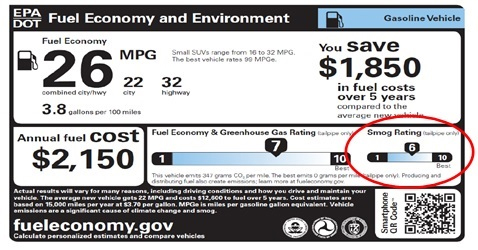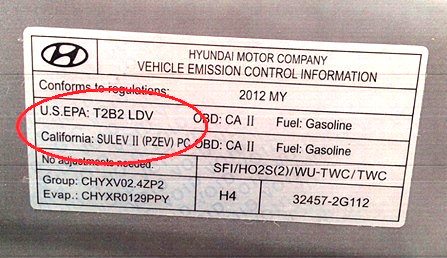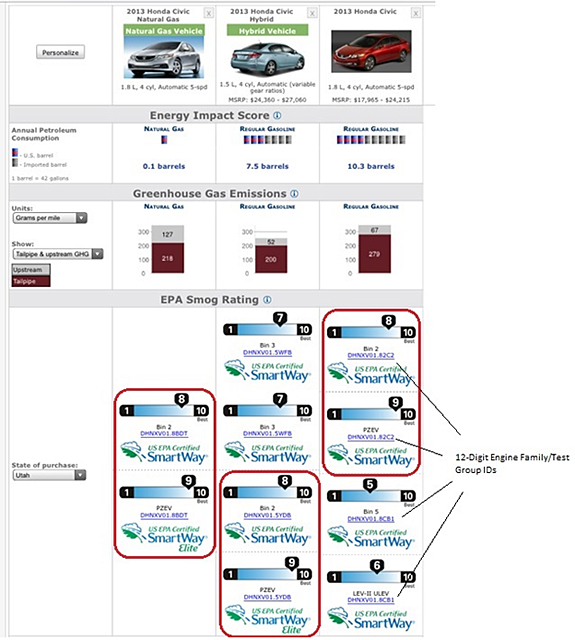The Division of Air Quality (DAQ) is encouraging consumers to consider cleaner cars when they purchase their next vehicle. Along the Wasatch Front, vehicles contribute over half of the emissions that form PM2.5. Choosing a cleaner car can help reduce these emissions and improve air quality.
Consumers wishing to reduce their emissions should ask the following questions when purchasing a car:
- What are the cleanest vehicles available at the dealership?
- What are the cleanest vehicles available for a given vehicle type (compact, midsize, SUV)?
- How can I identify a vehicle’s Smog Rating?
DAQ has put together the following information to help consumers answer these questions.
New Cars
Look for the Smog Rating located on the right-hand-side of the EPA/DOT Fuel Economy and Environment window sticker to identify the cleanest vehicles. Cars with a Smog Rating of 8, 9, and 10 have the lowest tailpipe emissions and are good choices for keeping Utah’s air clean. You can learn even more about a vehicle’s environmental attributes by scanning the QR Code on the window sticker with your Smartphone.
EPA/DOT Fuel Economy and Environment Window Sticker

Used Cars
Find the Smog Rating for used cars or cars that don’t have the above window sticker by locating the Vehicle Emission Control Information sticker on the underside of the hood. This sticker shows the vehicle’s emissions standard for EPA, California, or both.
Vehicle Emissions Control Information Sticker

Compare this standard to Smog Rating and Emissions Standards to determine the Smog Rating. Again, Smog Ratings of 8, 9, and 10 represent the cleanest vehicles.
Smog Rating and Emissions Standards
| Smog Rating | US EPA Tier 2 | US EPA Tier 3 | California LEV II | California LEV III |
|---|---|---|---|---|
| 1 (Worst) | ULEV & LEV II Large Trucks | |||
| 2 | Bin 8 (T2B8) | SULEV II Large Trucks | ||
| 3 | Bin 7 (T2B7) | |||
| 4 | Bin 6 (T2B6) | LEV II Opt. 1 | ||
| 5 | Bin 5 (T2B5) | Bin 160 | LEV II | LEV 160 |
| 6 | Bin 4 (T2B4) | Bin 125 | ULEV II | ULEV 125 |
| 7 | Bin 3 (T2B3) | Bin 70, Bin 50 | ULEV 70, ULEV 50 | |
| 8 | Bin 2 (T2B2) | Bin 30 | SULEV II | SULEV 30 |
| 9 | Bin 20 | PZEV/ATPZEV | SULEV 20/PZEV | |
| 10 (Best) | Bin 1 (T2B1) | Bin 0 | ZEV | ZEV |
Alternatively, visit the U.S. Department of Energy Fuel Economy Information page to find the vehicle in question. Select the Energy and Environment tab to identify the vehicle’s Smog Rating.
Consumers can also look at side-by-side comparisons of vehicles before heading to the showroom. Customers interested in finding the Smog Ratings for a range of vehicle makes and models can download the Green Vehicle Guide for the appropriate model year.
Some Models Have Been Certified For More Than One Smog Rating
For example, the 2013 Honda Civic is available with Smog Ratings ranging from 5 to 9. Those seeking to identify the cleanest vehicles should pay close attention to the 12-digit “Engine Family” or “Test Group ID” and the emissions standard certification level of the vehicle in question. This example also illustrates that many conventional, gasoline-powered vehicles are as clean as (or even cleaner than) some hybrid or alternative fuel vehicles. As indicated by the red boxes in the following example, the highest Smog Rating is available for all three models of the Honda Civic (natural gas, hybrid, and conventional gasoline-powered).
Example: 2013 Honda Civic

